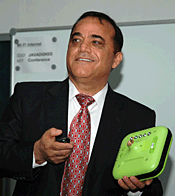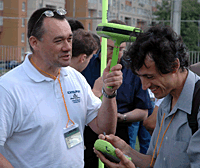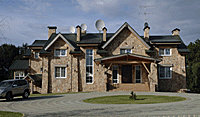Moscow — July 28, 2008 — Under sunny skies and beautiful Moscow summer weather, nearly 70 users and dealers from all over the world attended the first annual JAVAD GNSS user conference last week in Moscow, Russia. The first order of 100 TRIUMPH-1 receivers is now being distributed, with a second production run of 1,000 receivers in progress at the JAVAD production facility in San Jose, California. Yet to come will be another of JAVAD's revolutionary developments, the TRIUMPH-4X for RTK. Because the 4X incorporates four receivers in one, 16 baselines are created for each location, thereby making the work faster and more accurate. Delivery of the 4X is expected within four months.

After welcoming the crowd and covering a bit of the history of the company by Javad Ashjaee (right, with TRIUMPH-1), the fast-paced three-day program covered all aspects of the new JAVAD offerings. These included a wide range of NGS-certified antennas, and external modems. According to Javad, competitors have multiple modems to cover the range of frequencies, while the Javad modem covers the entire world with one design.
Also shown was an innovative RTK caddy holding TRIUMPH-4X and three additional antenna umbrella for the 4X. Based on a golf cart design, the benefits of the umbrella antenna configuration will be obvious under tree canopy: often the movement of the antenna by less than a foot will open a "path" to the sky. The umbrella makes moving the pole around unnecessary. The caddy design will prove particularly useful to GIS data gatherers.

In an outdoor demonstration (image left), the attendees witnessed first-hand the nearly instantaneous acquisition of a precise RTK location made possible by the state-of-the-art TRIUMPH chip. A unique range pole extension (image below, right) houses the RTK antenna, thereby eliminating all external cables.
In addition to the revolutionary new 216-channel TRIUMPH chip, the TRIUMPH-1 receiver incorporates a host of unique features, including In Band Interference Rejection (IBIR) and superior handling of GLONASS signals. IBIR will help with a problem that some precise users see: periods of the day when their equipment doesn't work. And according to Javad, until the Russians complete their current modernization efforts, the GLONASS signals won't be as useful for precise work as the GPS signals. Meanwhile, JAVAD technology has found a way around this disparity in usefulness by designing the receiver to mitigate it.

Also included were demonstrations of the JAVAD Victor handheld controller (image right). Based on a Juniper Systems design, the controller runs JAVAD Tracy software. This easy-to-use software incorporates three on-screen "buttons" that are all most users will ever need. If the button is green all is good. Operation by one or two clicks is all most users will need to gather data. Also innovative is a built-in field-office online data exchange capability.
Most of the presentations were made by the highly-educated Russian scientist/project managers who work in the Moscow office. Included was the GREIS/Giodis advanced geodetic post processing software and Justin surveying/GIS package. All of these state-of-the-art software packages incorporate the latest in the burgeoning availability of aerial and space-based imagery such as Google Earth.
Responding to questions about support, Javad unveiled a paradigm-shifting approach: an online forum that will include answers to the most commonly-asked questions. Because the company has people located all over the world, any questions not quickly answered by the dealers will be responded to within 24 hours.
Dispelling rumors that users will only be able to buy equipment online from the company website, Javad said that unless users have no dealer or don't like their dealer, the company expects most sales to be made through the dealer network.
A highlight of the conference was a presentation on GLONASS by Sergei Revnivykh from Roscosmos. Revnivykh admitted that, through the 1990s, investment in the system languished, but that now, funding has been assured, partly because the funding has been separated from the Russian space program. Modernization plans include an eventual constellation of 30 satellites, better clocks, longer satellite life (seven years versus the current three years), a switch to CDMA for signal transmission, interoperability and compatibility with other GNSS systems, and a global ground control segment like GPS (as opposed to the current Russia-only GCS). He assured the group that GLONASS signals will remain free, and expects these positive developments to start taking effect by 2010.

After the conference, many of the participants took advantage of the event to visit world-famous St. Petersburg, and after that, more than 150 employees, their families and guests took part in the annual JAVAD company party at Javad's country estate outside Moscow (image left). Highlighting the party was an operatic performance by three professional Russian opera singers accompanied by professional musicians. Plans are already underway for next year's event, as well as the first U.S. conference, to be held in the San Francisco Bay Area.